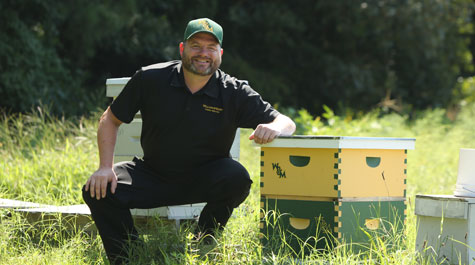W&M Dining Services cultivating honey for on-campus use
William & Mary students already eat lots of vegetables grown nearby as part of the university’s partnership with KelRae Farm, but this fall, menus will be abuzz with the addition of honey.
Stephen Moyer, W&M Sadler Center Court operation manager, is cultivating honey bees on the farm as the next step in exploring sustainability and healthy food options. Moyer had no previous experience with beekeeping but added the hives as part of his work managing the dining interns he works with to cultivate W&M’s vegetation rows at the farm.
“KelRae Farm had some bees,” Moyer said. “And I’ve always been interested in bees just because of what they do for pollination, and there’s been a massive decline in them. And I just thought well, that would be cool if we could help the farm as a whole bring in pollinators.
“And then as an afterthought to pollination would be to develop what we can do with honey.”
{{youtube:medium:right|rUnbfSmP1TM, W&M honey: From KelRae Farm to campus tables}}
Honey is a welcome addition, according to officials.
“W&M’s dining program has benefited from the fresh local produce that is planted and harvested each year by Dining Services staff and interns at KelRae Farm,” said Cindy Glavas, director of auxiliary services. “Being able to source local honey will be another great addition to the program from that partnership.”
The project is a growing part of campus-wide sustainability and local partnership efforts.
“Our partnership with KelRae Farm has blossomed — pun intended — under Stephen and the dining sustainability interns,” said Calandra Waters Lake, director of sustainability. “From dining halls receiving food grown on the farm with our own campus compost, to Sadler Terrace Farmers Markets, to team building and learning opportunities working the W&M rows, the connections continue to grow.”
With the help of a mentor at the farm, the university started building its own apiary, which takes a long time and yielded its first batch of honey at the end of June. The current two hives are only producing a small amount of honey, but Moyer said they’ll continue to grow, helping to pollinate all of the food that is harvested for the dining halls.
The honey is processed at KelRae, through a process of spinning in a centrifuge-type machine and filtering. The honey is primarily tulip poplar and clover, which are two of the biggest species that give up nectar for the area’s bees, according to Moyer.
“Basically, we got our honey in about three hours, which took probably 200,000 bees to make over two years,” Moyer said.
The current, small batch of honey will be used in a homemade honey balsamic salad dressing that will be available when classes start. Other possibilities are incorporating honey into specialty cookies, breads or bakery items. Dining is looking at the possibility of eventually producing enough honey to sell at its farmers markets, according to Moyer.
“We want to make it last as long as possible because it does take such a long time,” Moyet said. “The big productions, they have hundreds to thousands of hives; we have two. So I’m hoping that our honey will last until next year when we can bring some more in.”
Teaching about the importance of honey bees to the ecosystem is the main focus of the project, Moyer said. A W&M student intern is working with the KelRae Farm bee mentor to become a beekeeper.
“So we’re continuing to try to build on our successes with them, and teach and let everyone know the importance of honey bees,” he added.
 Skip to main content
Skip to main content

